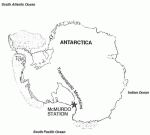A Long-Term Ecological Research (LTER) site for the Taylor Valley in the McMurdo Dry Valleys (MCM). approximately 100 km west of McMurdo Station, Antarctica has been funded through the Division of. Polar Programs at the National Science Foundation. An interdisciplinary team of scientists has been assembled—the majority with extensive field experience in the Antarctic who have made substantial contributions to the understanding of dry valley ecosystems.
The dry valleys are among the most extreme deserts in the world, far colder and drier than those represented in any previously established LTER site. The perennially ice-covered lakes, ephemeral streams, and extensive areas of soil within the valleys are subject to low temperatures, very limited precipitation, and salt accumulation. The biological systems in the valleys are relatively simple (e.g., no vascular plants or vertebrates and very few insects). Trophic interactions and biogeochemical nutrient cycles are largely limited to microbial populations and micro-invertebrates. Species diversity and abundance are low, as would be predicted for such extreme environments. Despite this simplicity, complex interactions among species and between the biological and physicochemical environment exists in the lakes, streams, and soils. Furthermore, interactions between various components of the ecosystems enhance the overall productivity of the dry valley landscapes. All ecosystems are shaped to varying degrees by climate and material transport, but nowhere is this more apparent than in the dry valleys.
The obvious effects of an extreme environment coupled with the general simplicity of ecosystem structure makes the dry valleys an ideal location to study these basic relationships. Two) central hypotheses embody this central theme:
- The structure and function of Taylor Valley ecosystems are differentially constrained by physical and biological factors
- The structure and function of dry valley ecosystems are modified by material transport
The MCM LTER project will address these hypotheses and the five core areas of LTER research emphasis through a program of systematic environmental data collection, long-term experiments, and model development. Research efforts will focus on the integration of the biological processes within—and material transport between—the lakes, streams and terrestrial ecosystems comprising the Taylor Valley landscape.
For more information: Robert A. Wharton, Jr., Biological Sciences Center, Desert Research Institute, 7010 Dandini Boulevard, Reno NV 89512, 702-673-7323, rWharton@LTERnet.edu (Internet).

 Enlarge this image
Enlarge this image